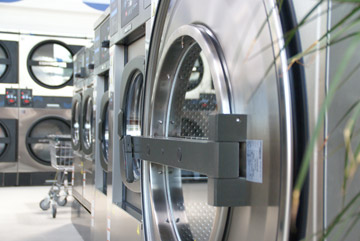Dryer Fires
A dryer fire constitutes a devastating and costly property insurance claim for laundries. Over the years, many laundries have been severely damaged as a result of dryer fires. Dryer fire culprits include lint buildup, improper installation and spontaneous combustion caused in garments containing grease, cooking oil, etc.
Due to the nature of lint, it can ignite and create a fire where the lint rapidly burns and spreads as far as there is lint to feed the flames. Therefore, it is crucial to reduce buildup of lint anywhere inside or outside the dryers. Prevention begins with a good maintenance regime and lint control. Developing a schedule to keep lint screens clean, removing lint from inside the dryer cabinet and cleaning out ductwork can be some of the simplest ways to achieve this.
The most common result of improper dryer installation is poor dryer performance and unhappy customers or employees. However, in severe cases, this can lead to fires. A few potential problem areas when it comes to dryer installation are poor location, incorrectly sized dryer exhaust, dryer exhaust restrictions, insufficient dryer makeup air, and improper gas and/or electrical connections.
Spontaneous combustion results from an exothermic reaction created in a tight bundle of hot clothes, especially if the garments are contaminated with grease, oil, cooking oil, gasoline or other flammable substances. The fires can occur in pockets, on shelves, in the dryer itself, or in a laundry basket. To prevent spontaneous combustion, always use a full cool down cycle on your dryer, never leave the dryer unattended when in use, never tightly fold garments that are still hot, and above all, avoid drying contaminated clothing or laundry items.
Washer drain valves and drain lines should always be kept clear of debris.
Lint within the laundry cycle is a given part of the process; you can only hope to reduce the amount. Foreign objects in the drain valve or drain line can easily be the thing lint needs to collect, once collected by the foreign object it is only a matter of time before the drain is plugged and the washer will no longer drain.
Things to look for that have been found in the drain line: bra under-wires by far are the most common, spoons, knives, forks, credit cards, rings, chains, hair rollers, hair pins, safety pins (always be careful).Try to make sure you empty pockets and shake out table linen before you put it into the washer. Inspect bras for loose or worn areas around the under-wires and repair as needed.
Being aware of the possible issues and incorporating a good inspection and shake out policy goes a long way to preventing unwanted down time, and the miserable job of dismantling the drain line (you will get wet, no way around it), to remove things that should not have gone into the washer to start with. Be safe!!
What is Lint?
Lint is small pieces of linen fibers, cotton, polyester, nylon, etc, that have broken away from the linen.
During the normal laundry process (both washing and drying) lint production is unavoidable just because of what the laundry process is and does, but it can be reduced!
Its production can be accelerated by several different means; those being:
- Excessive use of chemicals, this causes the linen fibers to become brittle and more readily break off.
- Excessive agitation, this is the equivalent to rubbing a hole in the linen as you beat it against a stone along the river bank.
- The most common cause of lint production is over drying. The more the linen is over dried the more brittle and the smaller the lint fibers become.
So how can we reduce the amount of lint production?
- Always follow the Soap manufacturer’s recommendations as to the correct amount of soap (more is not always better), bleach should be used sparingly as this contributes the most to lint production.
- Select the correct cycle for the type of linen being washed and make sure you take into account the soil level, if there is a lot of soil then add a prewash. Gentle cycles have their use, don’t wash everything on the same cycle.
- Always dry the linen in accordance with the manufacturer's recommendations and don’t forget that most linen under normal conditions has 3-4% moisture content. If you dry it to 100%, it will grab 3-4% from the air in the room when you take it out of the dryer.
What are the affects of lint?
- Lint will build up in the drain line and will require constant cleaning. The biggest cause of blockage in the drain line is a lint ball. Lint will cling to anything in the drain line (bra underwires, credit cards, necklaces, spoons, butter knives, forks, etc.) and once it starts it will not take long before the drain line is fully blocked.
- Lint is an excellent insulator and it will build up and keep the heat in the dryer. Unfortunately, it is also flammable so if it is not cleaned out regularly you will have a dryer fire.
- Lint will build up in the dryer exhaust and will require periodic cleaning. If lint builds up in the exhaust duct it will slow down the air through the dryer, making the dryer less efficient, raising costs and making the dryer operate at higher temperatures, which in turn could cause a dryer fire.
- Excessive lint production means that all that lint needs to come from somewhere. Your linen will have a reduced life expectancy as it is losing all the fibers it needs to stay together.
Reducing lint production and keeping your machines clean of lint will reduce operating costs, reduce service costs and reduce the risk of having a dryer fire. |


